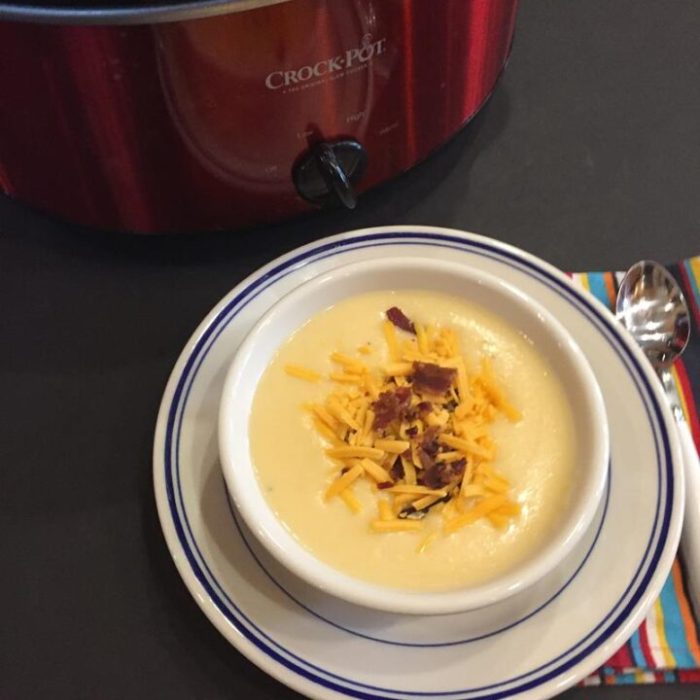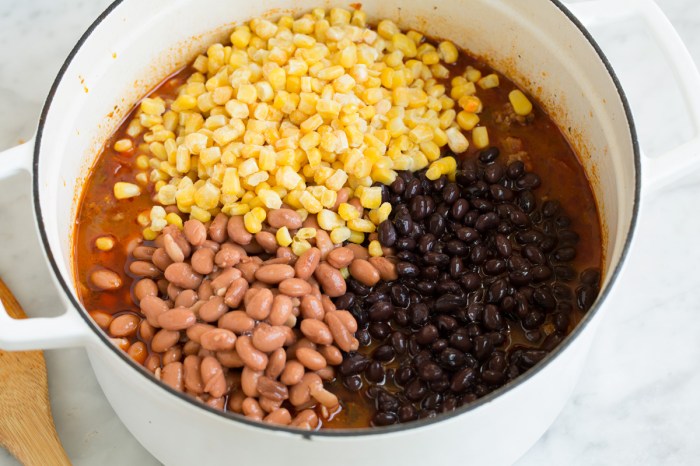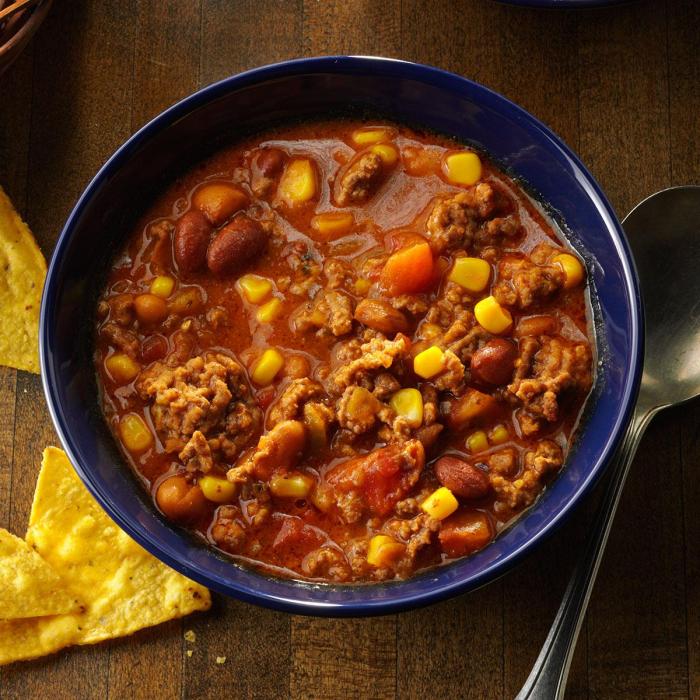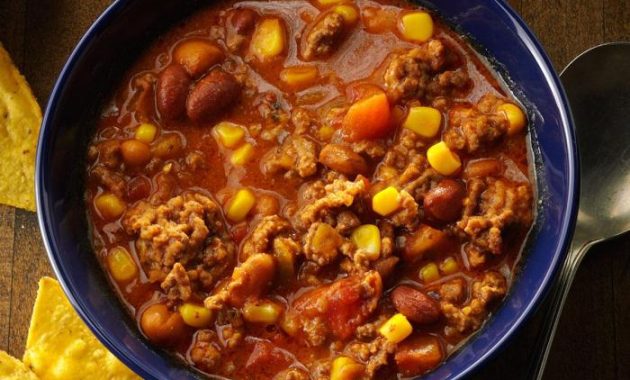No-Bean Taco Soup Recipe Variations
No bean taco soup recipe – This section explores diverse variations of our no-bean taco soup recipe, catering to different dietary preferences and flavor profiles. We’ll cover variations using chicken, beef, and vegetarian protein sources, alongside modifications for spicier and creamier versions. A table summarizing these variations will be provided for easy reference.
Recipe Variations: Protein Sources and Flavor Profiles
Three distinct variations of the no-bean taco soup are presented below, each showcasing a different protein source and highlighting unique flavor characteristics. A spicier version and a creamy version are also included.
| Name | Protein Source | Key Ingredients | Spice Level |
|---|---|---|---|
| Chicken Taco Soup | Shredded Chicken | Chicken broth, diced tomatoes, corn, onions, taco seasoning, cilantro | Mild |
| Beef Taco Soup | Ground Beef | Beef broth, diced tomatoes, corn, onions, taco seasoning, cheddar cheese | Medium |
| Vegetarian Taco Soup | Black beans (optional), Quinoa, or Mushrooms | Vegetable broth, diced tomatoes, corn, onions, bell peppers, taco seasoning, avocado | Mild to Medium |
Spicier No-Bean Taco Soup

Source: gfkitchenadventures.com
To enhance the spiciness, add a teaspoon or two of your preferred chili powder, cayenne pepper, or a few slices of jalapeño peppers to the soup. Adjust the amount based on your desired heat level. For a smoky heat, consider adding a chipotle pepper in adobo sauce.
Creamy No-Bean Taco Soup
Achieving a creamy texture involves incorporating a creamy element into the soup. This can be done by stirring in a dollop of sour cream, Greek yogurt, or a blend of cream cheese and milk towards the end of the cooking process. Blend a portion of the cooked soup using an immersion blender for an extra smooth consistency. Be careful not to over-blend, as this can result in a grainy texture.
Ingredient Substitutions and Their Impact: No Bean Taco Soup Recipe
This section details suitable substitutions for common ingredients, explores the effects of different broths, and provides instructions for making homemade taco seasoning. A bulleted list summarizes key substitutions and their potential impact on the final dish.
Suitable Substitutions for Key Ingredients

Source: cookingclassy.com
Several ingredients can be easily substituted to cater to dietary needs or preferences. This includes alternatives for tomatoes, onions, and spices, along with exploring the impact of various broth types.
Impact of Different Broths, No bean taco soup recipe
Using different broths significantly alters the flavor profile. Chicken broth provides a rich and savory base, beef broth adds a deeper, more robust flavor, while vegetable broth offers a lighter, more vegetarian-friendly option. The choice of broth depends on the desired taste and dietary requirements.
Homemade Taco Seasoning
To make homemade taco seasoning, combine 2 tablespoons chili powder, 1 tablespoon cumin, 1 tablespoon paprika, 1 teaspoon garlic powder, 1 teaspoon onion powder, 1/2 teaspoon oregano, 1/4 teaspoon cayenne pepper (optional), and 1/2 teaspoon salt. Adjust the quantities to your preference.
Ingredient Substitutions and Their Effects
- Diced Tomatoes: Substitute with crushed tomatoes, tomato paste, or fire-roasted diced tomatoes for a smoky flavor.
- Onions: Use shallots, leeks, or scallions for a milder onion flavor or a different textural element.
- Taco Seasoning: Utilize homemade seasoning for a more customized flavor profile, or experiment with different store-bought blends.
- Chicken Broth: Substitute with beef broth for a richer, more savory flavor, or vegetable broth for a lighter option.
- Corn: Substitute with black beans (if beans are allowed), or other vegetables like peas or diced bell peppers for added texture and flavor.
Cooking Methods and Techniques for No-Bean Taco Soup
This section compares and contrasts stovetop, slow cooker, and pressure cooker methods for preparing no-bean taco soup. A detailed step-by-step guide for the stovetop method is provided.
Stovetop vs. Slow Cooker vs. Pressure Cooker Methods
Stovetop cooking offers quicker preparation, allowing for more immediate control over the cooking process and the development of flavors. Slow cookers provide a hands-off approach, resulting in tender ingredients and a deeper, more developed flavor, but require significantly longer cooking times. Pressure cookers offer a faster cooking time compared to slow cookers, maintaining tenderness while delivering quicker results than stovetop methods.
Stovetop Method: Step-by-Step Guide

Source: windows.net
- Sauté onions and garlic in olive oil until softened. Add ground beef (or other protein) and brown until cooked through and crumbly. The resulting texture should be crumbly, not greasy.
- Stir in diced tomatoes, corn, taco seasoning, and broth. Bring to a boil, then reduce heat and simmer for 15-20 minutes, or until flavors have melded.
- Stir in any additional vegetables or garnishes during the last few minutes of cooking. Season with salt and pepper to taste.
- Serve hot, garnished as desired.
Pressure Cooker Method
Pressure cooking significantly reduces the cooking time. Follow the manufacturer’s instructions for your specific pressure cooker model. Ensure proper sealing and venting to prevent accidents. Start with sautéing the aromatics, then add all ingredients and cook under pressure for a specified time, usually around 10-15 minutes, depending on the protein used. Allow for natural pressure release before opening the lid.
No bean taco soup offers a lighter, flavorful alternative to traditional recipes. For a completely different seafood-based broth experience, you might consider exploring a delicious mussels recipe soup , which offers a briny depth. However, if you’re sticking to land-based ingredients, the simplicity and customizable nature of a no-bean taco soup makes it a perfect weeknight meal.
Serving Suggestions and Garnishes for Enhanced Presentation
This section explores creative serving suggestions and garnishes to elevate the presentation and flavor of your no-bean taco soup. A table summarizing the garnishes is provided.
Unique Garnishes and Serving Suggestions
Beyond the standard bowl, consider serving your no-bean taco soup in bread bowls, individual shot glasses, or even as a filling for baked potatoes. Creative garnishes enhance both the visual appeal and flavor profile.
| Garnish | Description | Flavor Profile | Visual Appeal |
|---|---|---|---|
| Avocado Crema | Pureed avocado blended with sour cream or Greek yogurt, lime juice, and cilantro. | Creamy, tangy, herbaceous | Vibrant green, smooth texture |
| Crispy Tortilla Strips | Thinly sliced tortillas, baked or fried until crispy. | Savory, slightly salty | Golden brown, crunchy texture |
| Chopped Cilantro and Lime Wedges | Freshly chopped cilantro and lime wedges provide a refreshing contrast. | Bright, citrusy, herbaceous | Green and yellow, contrasting colors |
Dietary Adaptations for No-Bean Taco Soup
This section Artikels modifications to make the no-bean taco soup gluten-free, low-sodium, and dairy-free.
Dietary Adaptation Options
- Gluten-Free: Ensure all ingredients, including broth and taco seasoning, are certified gluten-free.
- Low-Sodium: Use low-sodium broth and reduce or eliminate added salt. Season with herbs and spices instead.
- Dairy-Free: Omit any dairy-based garnishes like sour cream or cheese. Use dairy-free alternatives like coconut cream or cashew cream instead.
General Inquiries
Can I freeze leftover no-bean taco soup?
Yes, no-bean taco soup freezes well. Allow it to cool completely before storing in airtight containers for up to 3 months.
What are some good toppings besides the ones suggested?
Shredded cheese, avocado, sour cream, crushed tortilla chips, and chopped cilantro are all excellent additions.
How can I make this soup thicker?
You can thicken the soup by simmering it uncovered for a longer period to reduce the liquid. Alternatively, you can stir in a cornstarch slurry (1 tablespoon cornstarch mixed with 2 tablespoons cold water) at the end of cooking.
Can I use canned diced tomatoes instead of fresh?
Yes, using canned diced tomatoes is a convenient substitute. Just be sure to drain them well before adding them to the soup.

